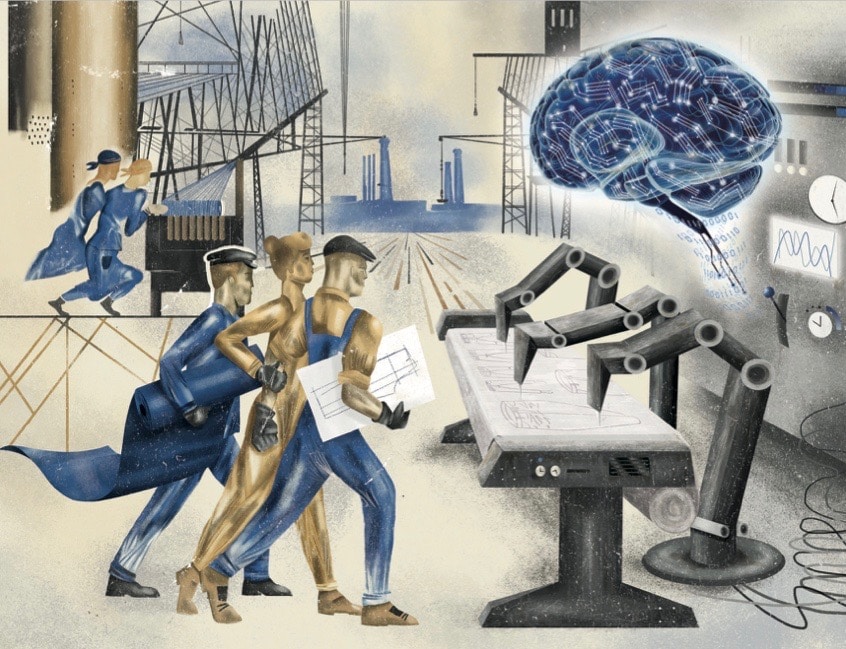This blog post is sponsored by Bluezone, the independent show for denim and sportswear by Munich Fabric Start. Register for the next show here!
We’re fashion people dabbling in technology. The future is going to be technical companies dabbling in fashion.”
Publisher David Shah told me so when we sat down at Munich Fabric Start’s Bluezone show in January 2018.
I’d booked David and a dozen other experts and influencers for an on-camera discussion of the show’s theme; how the future of denim will be driven by robotics, artificial intelligence and Big Data.
“Robotics imitate the physical movements of humans with mechanical processes,” David explained. “Artificial intelligence thinks and analyses like human brains. Data is the ammunition with which you feed robots and AI.”
The Pros and Cons of Big Data and AI
Big data has always been part of the fashion business, Stefano Aldighieri pointed out. Makers and brands gather information about sales performance and consumer feedback, and use it to forecast and design.
The term ‘big data’ is used to describe any voluminous amount of data that has the potential to be mined for information.
When it comes to the production and design of denim and jeans, we’re only witnessing the beginning of the era of artificial intelligence and Big Data, Maarten Wentholt said.
Bluezone’s denim curator, Panos Sofianos, argued that artificial intelligence is giving a lot of new opportunities for denim professionals to make their job better by predicting some of the errors that we’re doing.
However, Stefano fears that using artificial intelligence to design garments will flatten the creative process.
The Godfather of Denim himself argues that we still have a ways to go:
We’re still dealing with human intelligence, and we’re still having problems with that,” he told me, only half-joking.
The Difference Between Human and AI Design
Giovanni Petrin has spent a lifetime creating pre-washed jeans. He depicts that, within the next decade, his collections will be generated entirely by computers. But he’s not afraid of the bits and bytes. We humans still have something that computers don’t; a soul.
When I have the collection made by AI, I put my soul inside. This is the difference,” Giovanni concluded.
Designs made by humans have the human element, Stefano adds. “Sometimes we come up with things that are illogical or irrational but that somehow work.”
Take someone like Mohsin Sajid, who’s already not your average denim designer. He’s deeply passionate about and truly understands denim machinery. And he uses this knowledge when he designs and develops garments.
In the future, the job descriptions of denim designers and developers might also list ‘understands how to use artificial intelligence.’
The Benefits of Big Data and AI
The consumer immediately gets what he wants, Giovanni predicts. Orta’s Gulfem Santo also points out that artificial intelligence facilitates on-demand personalisation.
“We’re going to have a better product,” Adriano Goldschmied predicts. “We’re going to be able to produce a product that is going to be better in terms of quality of the fabric, in construction, in wash, and also in terms of fit and design.”
The key is to predict, David Shah concludes. “So, we’re all busy developing AI algorithms to be predictive. To tell you what to make, how much to make, and it what colour and what style to make it.”
And that’s going to change the whole business.
In a blog post I published in December 2017, you can learn more about the opportunities of artificial intelligence in the denim industry.
Supported by Munich Fabric Start’s Bluezone
This blog post is sponsored by Bluezone; Munich Fabric Start’s independent trade show for the denim and sportswear community.
The family-run Munich Fabric Start was established in 1996. Twice yearly, it attracts 20,000 fashion professionals to Munich. Bluezone was launched as the first denim-dedicated show in 2003. Today, it hosts more than 100 carefully curated exhibitors.
The show caters to all your sourcing needs: well-established ‘all-star’ mills; ‘catalyzers’ that create future trends in denim; and how new technologies and laundry solutions can make denim more sustainable.
Register for the next show here!
Disclaimer: Denimhunters was invited to Munich Fabric Start by the organisers. However, none of the individuals or companies mentioned in this blog post are affiliates.






